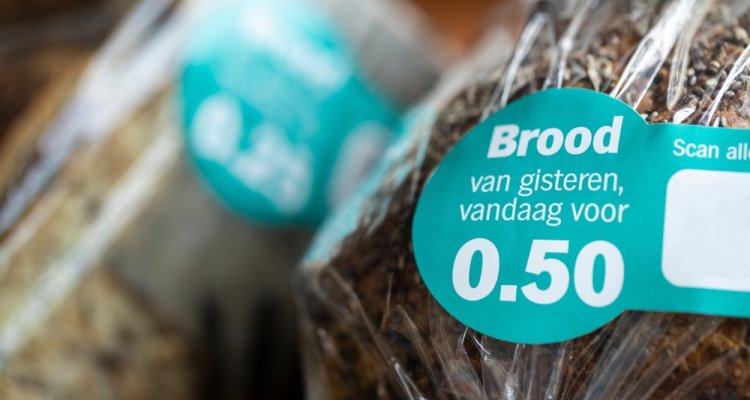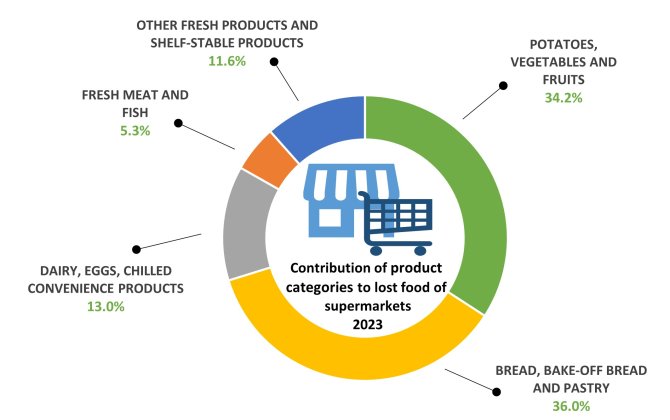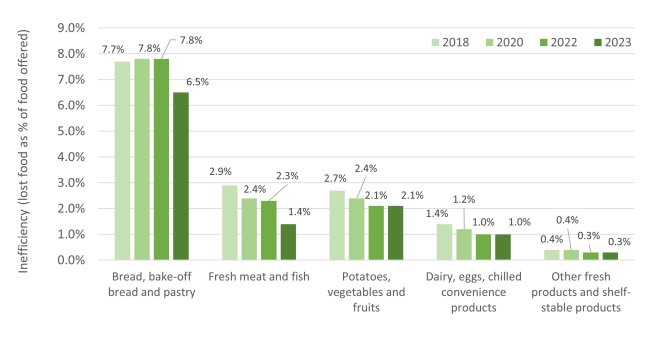
News
Food waste in supermarkets down to 0,89%
Food waste in supermarkets has further decreased to 0,89% of procurement volume in 2023. Compared to the initial measurement in 2018, this is a reduction of 35%. These encouraging figures were presented today to Minister Femke Marije Wiersma of Agriculture, Fisheries, Food Security, and Nature (LVVN). The findings come from the annual survey initiated by the Food Waste Free United Foundation and the Dutch Food Retail Association (CBL) which was conducted by Wageningen University & Research (WUR) based on self-reporting by supermarkets.
Minister Wiersma: “I am pleased to see that food waste in retail is decreasing. Our farmers, fishermen, and horticulturists work incredibly hard every day to put the highest quality food on our plates. Every kilo that we unnecessarily throw away is one too many; food waste is a downside of our prosperity, and there are still many people in the world who cannot afford that. Therefore, combating food waste deserves our utmost attention.”
Reducing footprint
Toine Timmermans, Director of the Food Waste Free United Foundation is delighted with this positive development: "We are really seeing an acceleration in the reduction of food waste in retail. That is largely related to the goals being targeted by supermarkets on reducing their own footprint. This was partly prompted by recently introduced legislation such as the CSRD Directive, which requires them to report on their social and environmental impact. Hopefully, this will allow them to set an example for other sectors."
Results by product group
The supermarket industry has been analysing food waste since 2018. Over 2023, the total waste fell further to 0,89% of procurement volume if we use the European definition of food waste, which is if the food does not go to humans or animals. Previous reports on food waste in retail were still based on losses: the total volume of products not going to people. This was 1.38% of the procurement volume of 2022. If we use the same definition now, the percentage of waste would be 1,21%. In the following product categories, we again use the same definition to enable proper comparison between the years. Here, the percentage of losses for human consumption compared to procurement volumes is:
- bread, part-baked bread and pastry: 6.5% (compared with 7.7% in 2018)
- fresh meat and fresh fish: 1,4% (compared with 2.9% in 2018)
- potatoes, fruit and vegetables: 2.1% (compared with 2.7% in 2018)
- dairy, eggs and chilled convenience products: 1,0% (compared with 1.4% in 2018)
- other fresh and non-perishable products: 0.3% (compared with 0.4% in 2018)
This shows that 'bread, pastry and part-baked bread' is the least efficient in terms of use for human consumption, with 6.5% lossesof the total procurement. Beverages are the most efficient category with only 0.2% losses of the total procurement.


Significant reduction on bread and meat/fish
The reduction is the result of supermarkets actively focusing on the categories of ‘bread & pastries’ and ‘fresh meat & fresh fish’. For some years, supermarkets have been pushing to sell all their bread, for example by selling yesterday's bread at a discounted price. This led to a 16% reduction compared with 2022. Despite this achievement, however, this product category still has the biggest losses.
The focus is also on reducing waste of 'fresh meat and fresh fish'. Because meat production has a relatively high ecological footprint, it is even more unfortunate if it goes to waste. For that reason, supermarkets have been devoting considerable attention to better stock management of these products. This resulted in a 37% reduction compared with 2022.
AI and shelf life symbols weapons in the fight against food waste
Supermarkets continue to actively promote further food waste reduction, says Marc Jansen, General Director of the Dutch Food Retail Association (CBL). "Supermarkets are heavily focusing on innovations in reducing food waste. For example, they are using Artificial Intelligence (AI) to improve the match between supply and demand. But new private label products are also being developed based on waste streams, such as pasta sauce from leftover tomatoes or biscuits and cake from leftover bananas."
Supermarkets are also working on consumer education, including storage advice and tips on how to use leftovers. Albert Heijn, Jumbo, Lidl, Dirk and DekaMarkt are also part of the Shelf Life Coalition. In this coalition, they have agreed to clarify ‘best before’ and ‘use by’ dates with a symbol on at least 50% of private label products. Research has revealed that lack of clarity about shelf life is one of the main reasons for food waste at home among consumers.
Movement in the entire food chain
Supermarkets are working with suppliers from the entire food chain to combat food waste. “We think it’s important that an increasing number of sectors are collectively measuring food waste to learn where most of the waste occurs, for example in the bakery sector, the meat sector and in the fruit and vegetable sector,” says Toine Timmermans.
Curious about the waste figures in your sector?
Together with Food Waste Free United and its stakeholders, Wageningen University & Research has developed templates that allow food waste to be measured throughout the food chain as well as in a specific sector. We have also developed methods to calculate the conversion to impact. Curious how this works for your sector? View our templates here.